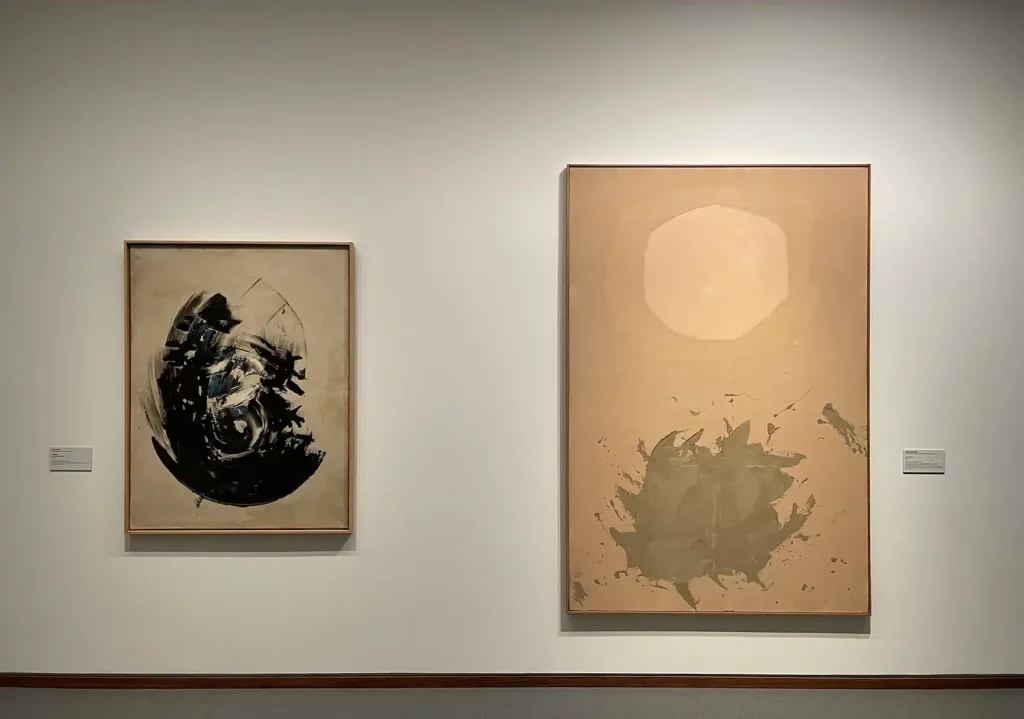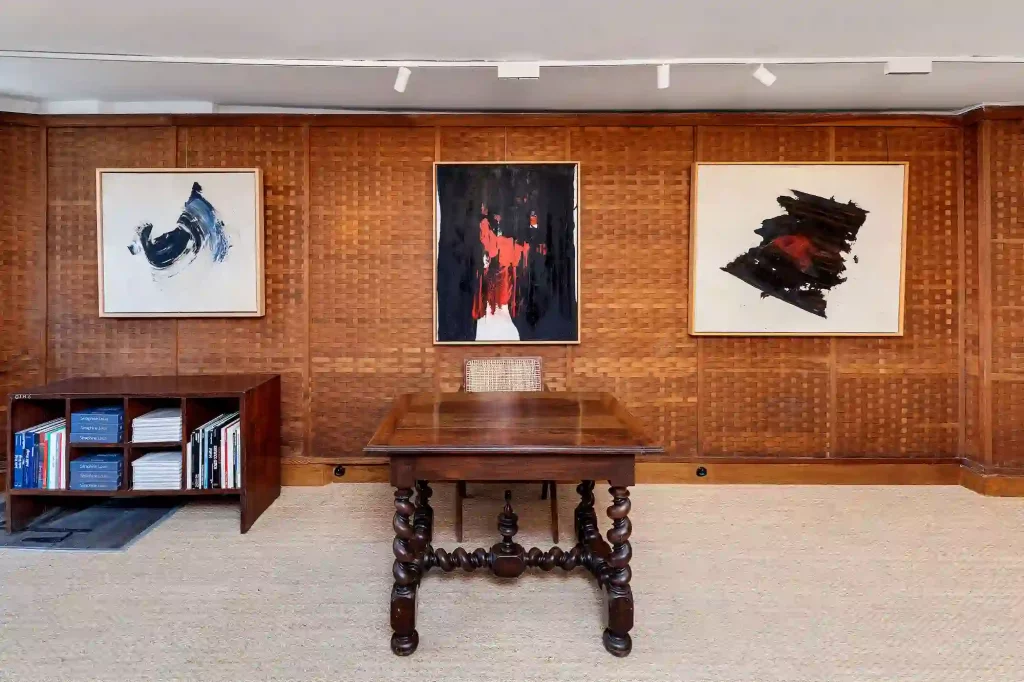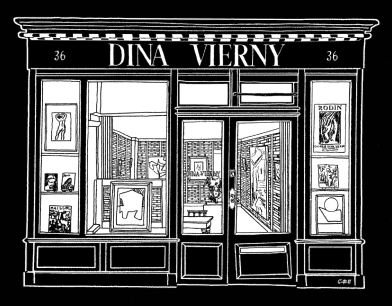All Exhibitions here
Last November, Berlin's Neue Nationalgalerie reorganised the layout of its permanent post-war collection. In this new version, entitled "Zerreißprobe" ("Test of Resistance" in French), central artistic and social themes of the 20th century are highlighted in fourteen sections, including realism and abstraction, politics and society, everyday life and Pop, feminism, identity, nature and ecology.February 6, 2024
 View of Judit Reigl's work (left) in the exhibition "Zerreißprobe. Kunst zwischen Politik und Gesellschaft Sammlung der Nationalgalerie 1945 - 2000" at the Neue Nationalgalerie in Berlin, 2023
View of Judit Reigl's work (left) in the exhibition "Zerreißprobe. Kunst zwischen Politik und Gesellschaft Sammlung der Nationalgalerie 1945 - 2000" at the Neue Nationalgalerie in Berlin, 2023 The title of the exhibition comes from the considerable diversity of materials, media and techniques that characterised the art of the second half of the twentieth century, a period that was particularly marked by division, rupture and transformation. Events such as the Holocaust, war, upheaval, emancipation, the Cold War and the fall of the Berlin Wall not only created tensions within society, but also provoked a fundamental shift and opening in visual art. For this exhibition, the Neue Nationalgalerie is taking as its starting point the radical performance "Zerreißprobe" (Stress Test, 1970) by Günter Brus, co-founder of Viennese Actionism, who in this performance pushed back the limits of his own body. The exhibition includes major works from West and East Germany, as well as from Western Europe, the United States and former socialist countries. It covers informal art, colour field painting, Pop art, Minimalism, as well as conceptual art with figures such as Marina Abramovich and Joseph Beuys.


View of the exhibition "Zerreißprobe. Kunst zwischen Politik und Gesellschaft Sammlung der Nationalgalerie 1945 - 2000" at the Neue Nationalgalerie in Berlin, 2023
Judit Reigl is one of the artists chosen for this exhibition, which focuses on post-war art. Among works by Rothko, Morris Louis, Arp, Moore, Calder and Gottlieb, we find "Centres de Dominance" dating from 1959. This painting is one of three donated to the institution by the Judit Reigl Endowment Fund in 2023. It was featured in the exhibition "Judit Reigl, Centers of Dominance", which commemorated the centenary of the artist's birth in the same year. The other two works donated to the Neue Nationalgalerie will be presented successively in the institution's permanent exhibition.

View of the exhibition "Zerreißprobe. Kunst zwischen Politik und Gesellschaft Sammlung der Nationalgalerie 1945 - 2000" at the Neue Nationalgalerie in Berlin, 2023
Placing Judit Reigl's work alongside the American Abstract Expressionists in this way is a way of showing the singularity of her work. Unlike the abstract painters of the École de Paris, whose works were always refined and composed in small and medium formats, Judit Reigl is violent, expressive and does not seek composition. Her large canvases bring her closer to the New York School than the Paris School: she is the missing link between the two sides of the Atlantic.

View of the exhibition "Judit Reigl, Centers of Dominance" at the Neue Nationalgalerie in 2023 © Jens Ziehe
In recent years, Galerie Dina Vierny has also presented two important "Centre de dominance" by Judit Reigl, both dating from 1958 (including the very first in the series). They were featured in the exhibitions "Judit Reigl, First Abstraction" in 2021 and "Judit Reigl, Panta rhei" in 2023.

View of the exhibition "Judit Reigl, First Abstraction" at the Galerie Dina Vierny in 2021, the "Centre of Dominance" on the left © Galerie Dina Vierny / Romain Darnaud

View of the exhibition "Judit Reigl, Panta rhei" at the Galerie Dina Vierny in 2023, the "Centre of Dominance" on the left © Galerie Dina Vierny / Romain Darnaud
Judit Reigl is one of the artists chosen for this exhibition, which focuses on post-war art. Among works by Rothko, Morris Louis, Arp, Moore, Calder and Gottlieb, we find "Centres de Dominance" dating from 1959. This painting is one of three donated to the institution by the Judit Reigl Endowment Fund in 2023. It was featured in the exhibition "Judit Reigl, Centers of Dominance", which commemorated the centenary of the artist's birth in the same year. The other two works donated to the Neue Nationalgalerie will be presented successively in the institution's permanent exhibition.
 View of Judit Reigl's work (left) in the exhibition "Zerreißprobe. Kunst zwischen Politik und Gesellschaft Sammlung der Nationalgalerie 1945 - 2000" at the Neue Nationalgalerie in Berlin, 2023
View of Judit Reigl's work (left) in the exhibition "Zerreißprobe. Kunst zwischen Politik und Gesellschaft Sammlung der Nationalgalerie 1945 - 2000" at the Neue Nationalgalerie in Berlin, 2023 Last November, Berlin's Neue Nationalgalerie reorganised the layout of its permanent post-war collection. In this new version, entitled "Zerreißprobe" ("Test of Resistance" in French), central artistic and social themes of the 20th century are highlighted in fourteen sections, including realism and abstraction, politics and society, everyday life and Pop, feminism, identity, nature and ecology.
The title of the exhibition comes from the considerable diversity of materials, media and techniques that characterised the art of the second half of the twentieth century, a period that was particularly marked by division, rupture and transformation. Events such as the Holocaust, war, upheaval, emancipation, the Cold War and the fall of the Berlin Wall not only created tensions within society, but also provoked a fundamental shift and opening in visual art. For this exhibition, the Neue Nationalgalerie is taking as its starting point the radical performance "Zerreißprobe" (Stress Test, 1970) by Günter Brus, co-founder of Viennese Actionism, who in this performance pushed back the limits of his own body. The exhibition includes major works from West and East Germany, as well as from Western Europe, the United States and former socialist countries. It covers informal art, colour field painting, Pop art, Minimalism, as well as conceptual art with figures such as Marina Abramovich and Joseph Beuys.
Judit Reigl is one of the artists chosen for this exhibition, which focuses on post-war art. Among works by Rothko, Morris Louis, Arp, Moore, Calder and Gottlieb, we find "Centres de Dominance" dating from 1959. This painting is one of three donated to the institution by the Judit Reigl Endowment Fund in 2023. It was featured in the exhibition "Judit Reigl, Centers of Dominance", which commemorated the centenary of the artist's birth in the same year. The other two works donated to the Neue Nationalgalerie will be presented successively in the institution's permanent exhibition.

View of the exhibition "Zerreißprobe. Kunst zwischen Politik und Gesellschaft Sammlung der Nationalgalerie 1945 - 2000" at the Neue Nationalgalerie in Berlin, 2023
Placing Judit Reigl's work alongside the American Abstract Expressionists in this way is a way of showing the singularity of her work. Unlike the abstract painters of the École de Paris, whose works were always refined and composed in small and medium formats, Judit Reigl is violent, expressive and does not seek composition. Her large canvases bring her closer to the New York School than the Paris School: she is the missing link between the two sides of the Atlantic.

View of the exhibition "Judit Reigl, Centers of Dominance" at the Neue Nationalgalerie in 2023 © Jens Ziehe
In recent years, Galerie Dina Vierny has also presented two important "Centre de dominance" by Judit Reigl, both dating from 1958 (including the very first in the series). They were featured in the exhibitions "Judit Reigl, First Abstraction" in 2021 and "Judit Reigl, Panta rhei" in 2023.

View of the exhibition "Judit Reigl, First Abstraction" at the Galerie Dina Vierny in 2021, the "Centre of Dominance" on the left © Galerie Dina Vierny / Romain Darnaud

View of the exhibition "Judit Reigl, Panta rhei" at the Galerie Dina Vierny in 2023, the "Centre of Dominance" on the left © Galerie Dina Vierny / Romain Darnaud
